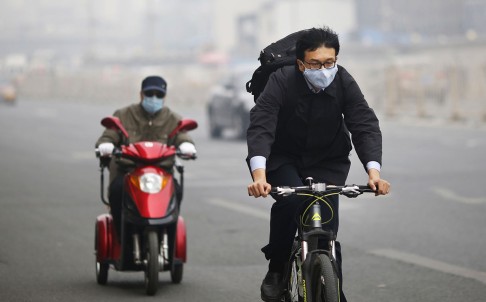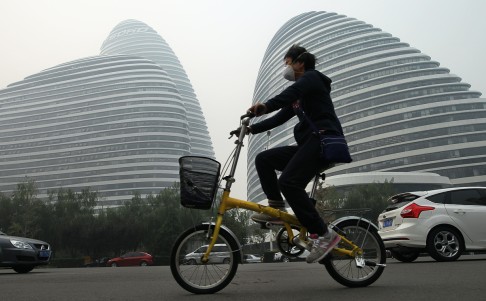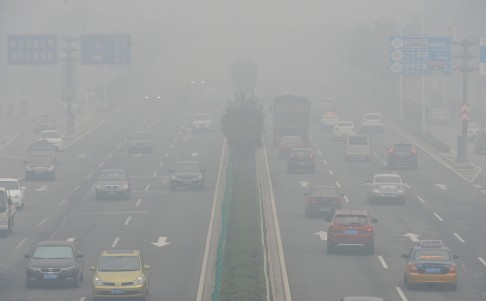Orange pollution alert raised as Beijing smog reaches 'hazardous' levels
Pollution level at the highest – “hazardous” – level meaning air quality is a health threat to the entire population as roads are closed and schools told to limit outdoor activities
PUBLISHED : Thursday, 09 October, 2014, 2:50pm
UPDATED : Thursday, 09 October, 2014, 6:15pm
Nectar Gan [email protected]

Commuters wear masks to escape the worst of the smog on Thursday. There is expected to be little respite from the pollution until the weekend. Photo: Xinhua
The capital’s second day of thick smog has prompted an orange alert – the second highest – for heavy pollution and resulted in almost 20 highways in the city and neighbouring provinces being partially closed in an attempt to cut down on fumes.
The Beijing pollution level remained at the highest – “hazardous” – level on Thursday morning, meaning air quality is a health threat to the entire population.
According to readings released by the capital’s environmental monitoring centre, the Air Quality Index (AQI) in central districts stood above 300 on Thursday morning, which is considered “hazardous”. Tiny PM2.5 particles – which lodge deep inside lungs and are the most dangerous to human health – were also recorded above 300 micrograms per cubic metre.
The smog forced the partial closure of 18 highways in Beijing, Tianjin, Heibei and Shanxi, including the highways between Beijing and Harbin, Beijing and Shanghai, and the Beijing-Hong Kong-Macau Expressway, the website of the China Meteorological Administration reported.
The roads were expected to be reopened to traffic by noon on Thursday, the report said.

A woman rides a bike passing by the Wangjing SOHO in Beijing on Thursday. Photo: Simon Song
After a day of dense pollution on Wednesday, conditions deteriorated further on Wednesday night. The US Embassy’s pollution data, published hourly on its “BeijingAir” Twitter feed, said Beijing’s AQI exceeded 400 at 4pm on Wednesday, and climbed to 455 between 9-10pm, before dropping to below 400 after 2am on Thursday. The density of the PM 2.5 particles reached 432 micrograms per cubic metre at its peak.
The Beijing Municipal Environmental Monitoring Centre put the AQI figure on Wednesday night between 330 and 350.
The capital’s municipal government held an emergency meeting on Wednesday evening to discuss the response measures. It suggested schools reduce outdoor sports activities and ordered highway authorities to spray water on to roads to reduce dust. Crop stubble burning by farmers and outdoor barbecues in cities were strictly forbidden.
Authorities said they expected the dense pollution to continue until Saturday, with little sign before then of the strong winds needed to disperse the pollutants.

Motorists drive through Shijiazhuang, capital of Hebei Province, on Thursday. Many northern areas are suffering from the pollution. Photo: Xinhua
Besides Beijing, some parts of Tianjin, Hebei and Henna also reported heavy smog.
The Beijing Municipal Bureau of Environmental Protection said the heavy pollution was caused by “unfavourable” weather conditions and regional pollution. The still air in the capital prevent the pollutants from dispersing, and the persistent southerly wind also brought in further pollutants, increasing the PM2.5 count in the city.
